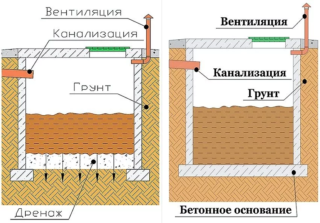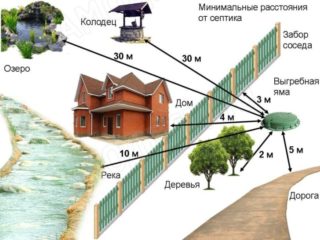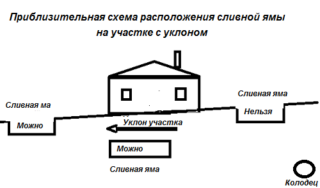In the absence in a private house of the possibility of connecting to the central sewage main, its owners are allowed to build a local treatment plant. An inexpensive option is to equip a cesspool with your own hands. It is important to design the structure in accordance with all the rules so as not to violate sanitary and building codes and regulations and not to fall under administrative responsibility.
Sanitary and building codes in the design of a cesspool

In accordance with SanPiN 42-128-4690-88, it is allowed to install a filter cesspool in summer cottages and in buildings for temporary use. On the backyard of the cottage, it is possible to build only a sealed device.
In the first variant, the installation of an impenetrable bottom for a pit with a volume of up to three cubic meters is optional. The principle of operation of the retraction mechanism is as follows:
- Through the drain located in the upper part of the chamber, drains enter the well.
- The settling of solid fractions occurs.
- The liquid enters the ground through the holes in the sidewalls and the filter bed equipped at the bottom.
To clean the sediment masses, a two-layer pillow is made at the bottom of the cesspool. Sand mixture and gravel or crushed stone of medium and coarse fraction are filled in. The thickness of the sand layer is up to 20–30 cm, of crushed stone - up to 50 cm. The use of fine-grained crushed stone is non-functional: over time it becomes compacted, and it is more difficult for drains to pass through the cushion.
According to the standards, the filtration sewerage tank needs to be systematically emptied from sediment accumulating at the bottom. Cleaning is performed at least once every two months. It is forbidden to use a structure without a bottom with a volume of drainage fluid exceeding a cubic meter in 24 hours.
If plumbing is installed in the house and more than two people live at the same time, according to sanitary standards and SNIPs, the drain pit must be sealed. The same applies to cottages where they live on a permanent basis. Insufficiently treated wastewater can get into subsoil sources that feed a well or a well. Drinking water from it carries health risks. Also, sealed sewer devices protect the fertile soil layer from the penetration of household chemicals residues.
The principle of operation of a sealed well or a pit is as follows: through the drain pipeline, wastewater enters the storage tank. After reaching the permissible level, the sewers are called.
For purification, special equipment is used, independent pumping of sewage, as well as disinfection of the well with bleach, is not allowed.
Among the main requirements for the arrangement is compliance with the installation depth conditions. To prevent flooding of the well, it is necessary to calculate the dimensions of the pit so that the groundwater level is no higher than 90 cm from the bottom of the chamber. The greatest depth for sealed containers is 3 m, which is due to the peculiarities of the sewage treatment equipment.
Another important requirement is that the bulk of the waste should be located below the level of freezing of the earth. And the maximum filling level of the container should be 35 cm below the lid. The cesspool, regardless of the design, should be equipped with a ventilation pipe with a cross section of 100 mm or more. Ventilation outlet above ground level not less than 70 cm.
Requirements for materials
For the arrangement of cesspools the following are most often used:
- Concrete and reinforced concrete rings.Finished perforated products are used to install a well with a drain through the walls and bottom. The connection is carried out using factory locks or a sealing compound. At the top, a sealed cover and ventilation outlet are required.
- Brick. Laying is carried out on a mortar with the creation of filter slots to drain the liquid into the ground.
- Plastic. Installation of a polymer tank is the optimal solution for a sealed cesspool. The walls of the products consist of several layers, thereby reducing the likelihood of freezing and cracking. Their service life is up to half a century.
The complete set of factory-made storage devices includes a sealed cover, internal steps for maintenance, a ventilation outlet in the upper part, a branch pipe for connecting a pipeline. The containers are available with smooth walls for easy cleaning.
Location selection
- At least 5 m - from the wall or foundation of a residential building. The maximum distance from the house to the cesspool is 12 m. With a greater distance, there is a risk of problems with the outflow of liquid in the pipeline.
- A meter from a bath, a barn or other outbuildings.
- The distance from the cesspool to the border of the site is 2–4 m. This concerns the fence of neighbors. From the side of the road adjacent to the site, the indent is 5 m.
- The minimum distance to garden plantings, flower beds is from 4 m.
When planning a cesspool, a soil study is always carried out in order to determine its composition. It takes into account how much moisture it can absorb. In addition, special maps are used to determine in which direction groundwater flows are moving. Installation is carried out in a place that is below the level of the location of the water intake point.
The distance from the well to the cesspool is determined individually, and depends on the composition of the earth and the direction of movement of subsurface sources.
Sanitary standards regulate not only the distance from a water well or well to a cesspool. The location of the water supply pipes must also be taken into account. The distance from the pit to them depends on the pipeline material:
- more than five meters - from the asbestos-cement main;
- more than one and a half meters - from the cast iron pipeline;
- more than one and a half meters - from the plumbing wiring made of plastic.
If the building is located near a school or kindergarten, the distance from the storage tank to the border of the territory of the educational institution is at least 20 meters. If a reservoir is located nearby, then the cesspool is equipped 30 m from the shore.
When calculating the distance from the cesspool to the neighbors, the wind direction is also taken into account. The treatment plant must be located so that sewer odors do not reach residential buildings.
To resolve issues that may arise when arranging a pit, the owner of a private cottage should contact the local administration.
Drawing up a plan and obtaining permits
The first thing to do is to plan the location of the sump:
- A plot diagram is drawn on a sheet of paper.
- The location of the building, outbuildings and water intake points is indicated with the highest possible accuracy, with the determination of the distances between them.
- The position of the water main is determined.
- The distance between buildings and the boundaries of the territory is indicated.
- The position of garden paths, small architectural objects, trees and shrubs is schematically indicated.
- The direction of movement of groundwater is determined.
- The soil composition on the site is recognized.
It is advisable to create a large-scale plan at a rate of 1: 100.
Failure to comply with the requirements for the installation of cesspools and other treatment facilities causes contamination of drinking water sources and contamination of the soil. The construction of a cesspool is coordinated with the sanitary inspection authorities and the water utility. This must be done in order to obtain a building permit. The cost of the documents will be about 200 rubles.
If there is no permitting documentation for the installation of a sewer well, there is a risk of imposing fines ranging from 500 rubles to several thousand.
The correct position of the cesspool is important due to the fact that in the process of bioprocessing of wastewater, sulfur gas and methane are released, which pose a threat to health and the environment.
If there are restrictions on the area of the site, it is worth contacting the local authorities of the water utility and Rospotrebnadzor. After analyzing the situation, it is possible to reduce the standard distances.











And what kind of site should be in order not to break all the rules, taking into account the planting of trees ??? At least 30 by 40. And most have 6-8 acres. And how to be ???